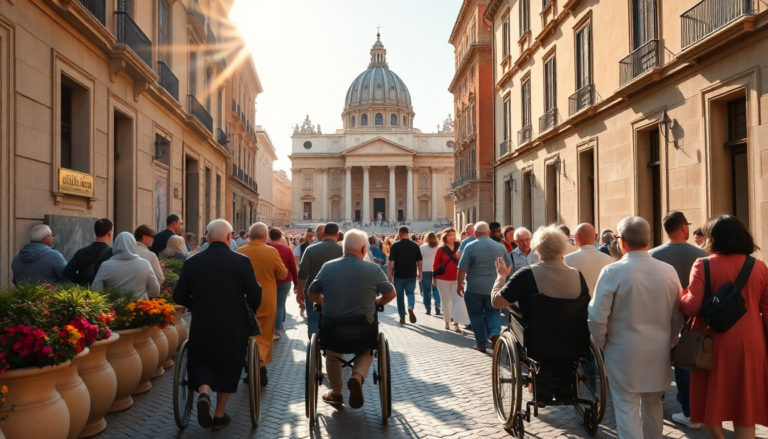Imagine strolling through the vibrant streets of Rome, with the footsteps of countless pilgrims echoing around you, all making their way towards the Holy Door of St. Peter’s Basilica. Now, picture this sacred journey being accessible to everyone, regardless of their physical abilities or sensory needs. The City of Rome is taking significant strides to ensure that the upcoming Jubilee in 2025 is not just a religious event, but a truly inclusive experience for all who visit this historic city. The inauguration of three distinct pathways leading to the Holy Door stands as a testament to this commitment, featuring accessible maps, QR codes, and user-friendly signage designed to guide every visitor along their pilgrimage.
Accessibility in the Heart of Rome
The newly established routes begin at three key locations: Piazza del Risorgimento, Piazza Pia, and Piazza Sant’Uffizio. Each pathway boasts inclusive signage that enables individuals with varying physical, sensory, cognitive, and linguistic backgrounds to navigate their way to the Basilica with ease. Central to this initiative are accessible maps, designed to be user-friendly for everyone. These maps aren’t just available in print; you can also access them online, allowing for some pre-planning before you set out on your journey.
Each map is truly a treasure trove of information, incorporating text, audio, and video in multiple languages. As you make your way along the route, you’ll discover details on rest areas, restroom facilities, water fountains, special assistance services, and traffic lights—everything you might need on your pilgrimage. The languages offered include Italian, English, Italian Sign Language, and an Easy-to-Read format regulated by the European Union, ensuring clarity and understanding for all users. The aim is not merely to provide a new experience but to cultivate an atmosphere of accessibility, embracing the true spirit of inclusivity.
Designing for All
Thoughtful design choices lie at the heart of these maps. Special fonts, like ‘Test Me’, are chosen to facilitate reading for individuals who are visually impaired or have dyslexia. Braille is incorporated into the printed materials, and the tactile maps feature raised illustrations to assist those with limited vision. Each map includes two QR codes that, when scanned, lead users to a welcoming video in Italian, complete with synchronized subtitles and a sign language interpretation, along with an explanatory video detailing the route.
When it comes to organizational clarity, the city has truly gone above and beyond. No matter your starting point, the pathways are clearly marked throughout. Colorful footprints, spaced five meters apart on the pavement, guide pilgrims directly to the Basilica. These vibrant markers reflect the Jubilee of Hope logo, symbolizing the richness of human diversity and making it impossible to miss your destination.
Exploring the Pathways
Let’s take a closer look at the three distinct pathways leading to the Holy Door. Starting from Piazza Pia, the journey to St. Peter’s Basilica is a comfortable ten-minute walk, primarily along Via della Conciliazione, where you’ll encounter cobblestones and a couple of ramps. From Piazza del Sant’Uffizio, the Basilica is nearly within sight, with a route that alternates between cobblestones and ramps, including the necessary security checks. The third route, beginning at Piazza del Risorgimento, takes about seven minutes, faithfully following Via di Porta Angelica, with a mix of cobblestones and ramps along the way.
None of these routes are daunting; they are all conveniently close to the Basilica, designed to offer an inclusive alternative for pilgrims who may find longer, more challenging paths difficult. This initiative exemplifies the city’s dedication to ensuring that everyone can partake in this sacred experience, celebrating the shared journey to the Holy Door. So, whether you’re a seasoned traveler or a first-time visitor, the doors of Rome are open wide, welcoming you to a pilgrimage that honors both tradition and accessibility.

